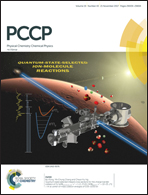Quantum-state-selected integral cross sections for the charge transfer collision of O2+(a4Πu5/2,3/2,1/2,−1/2: v+ = 1–2; J+) [O2+(X2Πg3/2,1/2: v+ = 22–23; J+)] + Ar at center-of-mass collision energies of 0.05–10.00 eV
Abstract
By employing the sequential electric field pulsing scheme for vacuum ultraviolet (VUV) laser pulsed field ionization-photoion (PFI-PI) detection, we have successfully recorded the spin–orbit and rovibronic state resolved VUV-PFI-PI spectra for O2+(a4Πu5/2,3/2,1/2,−1/2: ν+ = 0–2; J+) and O2+(X2Πg3/2,1/2: ν+ = 21–23; J+), indicating that O2+(a4Πu) and O2+(X2Πg) ions in these spin–orbit and rovibronic states can be prepared for ion–molecule collision studies. The present experiment is concerned with the measurement of absolute integral cross sections (σ's) of the charge transfer reactions, O2+(a4Πu5/2,3/2,1/2,−1/2: ν+ = 1, 2; J+) [O2+(X2Πg1/2,3/2: ν+ = 22, 23)] + Ar → Ar+ + O2. The fact that the O2+(a4Πu5/2,3/2,1/2,−1/2: ν+ = 1) and O2+(X2Πg3/2,1/2: ν+ = 22) [O2+(a4Πu5/2,3/2,1/2,−1/2: ν+ = 2) and O2+(X2Πg3/2,1/2: ν+ = 23)] states are in close energy resonance, makes these reactions ideal model systems for investigating the energy resonance and Franck–Condon factor (FCF) effects on the charge transfer reactivity of O2+. The σ(a4Πu5/2,3/2,1/2,−1/2: ν+ = 1, 2) values are found to be about ten-fold higher than the σ(X2Πg3/2,1/2: ν+ = 22, 23) values at Ecm = 0.05–10.00 eV, indicating that the FCFs play a predominant role in promoting these charge transfer reactions. The present ion–molecule reaction study also shows that σ(a4Πu) depends strongly on the spin–orbit as well as the vibrational states with the order: σ(a4Πu: v+ = 2) > σ(a4Πu: v+ = 1), and σ(a4Πu5/2: v+) > σ(a4Πu3/2: v+) > σ(a4Πu1/2: v+) > σ(a4Πu−1/2: v+), where v+ = 1 and 2. The high σ(a4Πu5/2,3/2,1/2,−1/2: v+ = 1, 2) values, along with their decreasing trend with increasing Ecm, are consistent with those expected for a long range charge transfer mechanism. However, the low σ(X2Πg3/2,1/2: ν+ = 22, 23) values and the lack of Ecm-dependence observed in the Ecm range of 0.05–10.00 eV point to the involvement of short-range collision dynamics.
![Graphical abstract: Quantum-state-selected integral cross sections for the charge transfer collision of O2+(a4Πu5/2,3/2,1/2,−1/2: v+ = 1–2; J+) [O2+(X2Πg3/2,1/2: v+ = 22–23; J+)] + Ar at center-of-mass collision energies of 0.05–10.00 eV](/en/Image/Get?imageInfo.ImageType=GA&imageInfo.ImageIdentifier.ManuscriptID=C7CP04886F&imageInfo.ImageIdentifier.Year=2017)
- This article is part of the themed collection: 2017 PCCP HOT Articles


 Please wait while we load your content...
Please wait while we load your content...